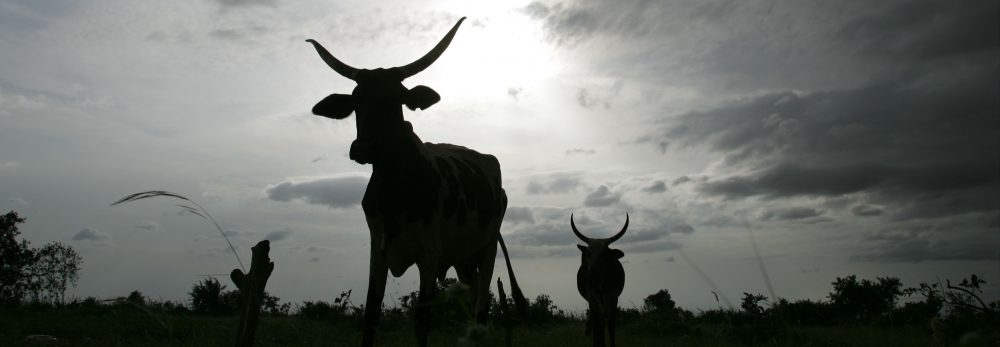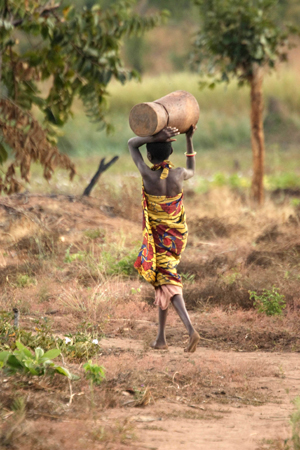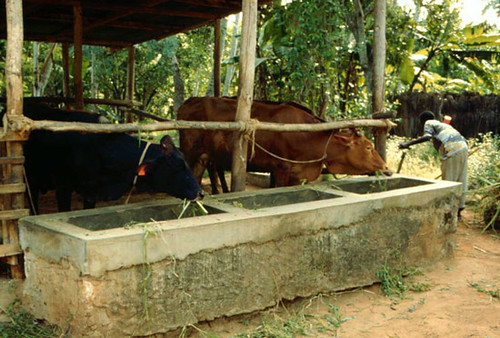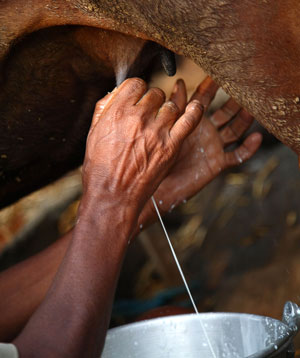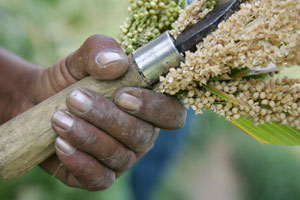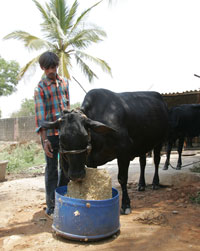|
A report by the United Nations Food and Agriculture Organization (FAO) in April 2008 concludes that policy decisions impinging on the smallholder dairy sector should be taken with a broad understanding of their direct and indirect implications on rural as well as urban populations.
The report indicates that the recent control of milk prices in several Asian countries could be counter-productive to supporting the dairy incomes of smallholders and rural development generally. With prices at record levels for both dairy outputs (milk) and inputs (feeds, energy costs), fixed and administered prices tend to hold back big as well as small dairy producers from responding quickly to the changing price signals.
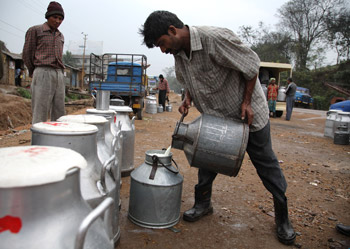 Price controls particularly hurt dispersed smallholders, who often lack social networks to help them find and sell to milk collectors offering the highest prices. On the other hand, equitable and remunerative prices for farm-gate milk encourages smallholders to adopt improved and sustainable technologies and management systems that improve their milk quality as well as quantity. Price controls particularly hurt dispersed smallholders, who often lack social networks to help them find and sell to milk collectors offering the highest prices. On the other hand, equitable and remunerative prices for farm-gate milk encourages smallholders to adopt improved and sustainable technologies and management systems that improve their milk quality as well as quantity.
The recent and rapid escalation of commodity prices is the perfect environment in which to test what policies are most conducive to the development of the agricultural sector. Low food prices over the past 20 years led to an underinvestment in agriculture, particularly in smallholder dairying, which, unlike rice and other staples of food security, has been a neglected and relatively unsupported area of research and development.
Fair pricing policies, says FAO, are the first step to this sector’s development.
<><><>
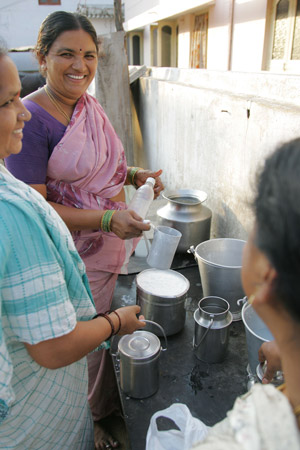 The sudden rise in dairy prices that took the market by surprise in late 2006 was due to the elimination by the European Union of subsidized dairy exports as well as to drought in many large dairy-product exporting countries and higher feed prices worldwide. Throughout 2007, prices for dairy products rose faster than those for any other agricultural commodity group, finally reaching a plateau in late 2007 and abating only in early 2008. The sudden rise in dairy prices that took the market by surprise in late 2006 was due to the elimination by the European Union of subsidized dairy exports as well as to drought in many large dairy-product exporting countries and higher feed prices worldwide. Throughout 2007, prices for dairy products rose faster than those for any other agricultural commodity group, finally reaching a plateau in late 2007 and abating only in early 2008.
This recent increase in dairy prices potentially offers an opportunity for hundreds of millions of poor, and in many cases, landless, smallholder dairy producers to benefit from these structural, or permanent, shifts in the global demand and supply of dairy products.
This is particularly true for Asia, where growth in both milk production and consumption has been the strongest in the world; nearly 80% of the 238 million tonnes of milk produced in 2007 was supplied by farmers with 1 to 5 cows.
While developing countries in Asia and elsewhere consume only 40% of global milk production, these countries import nearly three-quarters of global shipments of dairy products, including 80% of milk powder exports from developed countries. With the world’s largest net trade milk deficit, Asia is projected to increase its milk production by 3% a year over the next decade, slower than the previous decade but still double annual global growth rates.
This is supported by expectations that, although dairy product prices have been easing in the first half of 2008, increased prices are here to stay. Commodity projections by both FAO and the Food and Agriculture Policy Research Institute indicate that milk prices over the next decade will remain 50% higher than historical averages.
Smallholder farmers have the capacity to respond quickly to higher milk prices because of their ample scope for rapid yield increases. Current average milk yields in developing countries are just one-fifth that in developed countries because most smallholder farmers feed their dairy animals well below their potential.
With enabling pricing policies and technical support to producers on improved feeding, on-farm management and reducing spoilage, milk yields in poor countries could increase dramatically to meet the rising global demand, bringing millions out of poverty in the process.
How policymakers in region have responded to higher commodity prices
To date, most of the policy responses in Asia to escalating food prices have focused on rice, maize, wheat and other food staples. Some countries, such as India in 2007, briefly limited dairy product exports to ensure domestic price stability. Many importing countries reduced import tariffs on both livestock products and feed inputs and many put in place price caps on milk and other dairy products.
Asian policy responses to escalating food prices
• China imposes price caps on meat, milk, eggs, grain and edible oils (Jan 2008)
• China subsidizes meat consumption for the poor (for 6 months)
• Thailand imposes price controls on dairy products, chicken, eggs, beef and pork.
• Pakistani cities set retail fluid milk prices below the cost of production.
• Thailand reduces the tariff rate for soybean meal from 4 to 0% to reduce the costs of feeding local animals.
• Indonesia eliminates import duties on soybeans (for 6 months).
• Indonesia subsidizes tempe and tofu producers.
• Korea cuts import duties on corn and soybeans.
• China reduces the tariff rate for soybeans from 3 to 1% for 3 months (Oct 2007–Mar 2008).
• Indonesia takes a series of measures to stabilize food prices.
• India abolishes the import duty on corn (Jan–Dec 2007)
• India bans the export of pulses (Jun 2006–Mar 2008).
• Vietnam reduces tariffs on meat, offal, eggs, milk products, vegetable oils and animal feeds by 30–50% and reduces the import tax rate for corn used for animal feed from 5 to 2%.
|
The different policy responses and the way they are implemented alter economic incentives for the different actors along the dairy marketing chain and have differential impacts on food security in urban and rural areas. Policy responses that seek to ensure food security and access by controlling markets, such as through setting ceiling prices, usually lower prices, preventing potential gains from being realized, and hurt rural livelihoods.
The dairy sector in most developed countries is highly supported through regulated prices and high tariffs to ensure stable and high incomes for dairy producers. This is not the case in developing countries, where dairy policies are less prevalent and price controls are often used to ensure low prices for urban consumers.
A recent FAO review on lessons learned in smallholder dairy development reveals that government interventions in the dairy sector—particularly price policies that create or remove incentives for producers to increase yields—strongly impact rural livelihoods and food security for better or worse, as well as, importantly, the investment climate for the sector.
A key question for policymakers is to what extent the international dairy prices are being transmitted into local economies. FAO’s investigation of price movements in a few countries in Asia identifies some of the factors conditioning the transmission of the prices. Domestic policies influence market signals while the costs of doing business determines the extent to which individual producers respond to those market signals.
The first determinants of how international prices translate into local prices are exchange rate movements and a country’s net trade position. While world dairy prices have increased substantially in recent years, these have been accompanied and partly caused by a substantial depreciation of the US dollar against many currencies.
The exchange rate factor means domestic prices don’t necessarily rise as much as international prices. The impacts of international prices on local prices are highest in countries with stable currencies, such as Indonesia and Bangladesh. In countries whose currencies have been appreciating, milk importers such as the Philippines have benefited from cheaper imports while milk exporters such as Thailand have suffered from reduced export earnings.
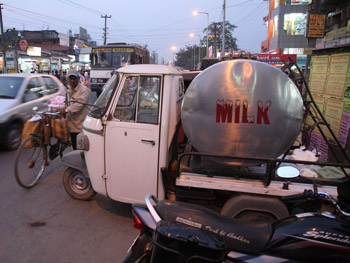
Prices of dairy products throughout Asia have increased over the past two years. From 2006 to 2008, farm gate prices of fluid milk rose from 10% (Malaysia) to 14% (Nepal) to 30% (Vietnam) to 69% (Mongolia). In the Philippines, which, after China, imports more dairy products than any other Asian nation, the government stopped all support for dairy activities two decades ago, deciding to import all its dairy requirements. While the government has accorded the sector more interest in recent years, its low tariffs (1–3%) on dairy imports, instituted to assure adequate supplies of milk products for its urban consumers, encouraged milk imports.
Despite these challenges to Philippino dairy producers, the smallholder sector, comprising some 96% of the dairy farming sector, has managed to compete favourably in the open market, due to its enterprise-focused approach to dairy development and the laissez-faire pricing policy, which allows markets to determine prices. The rise in international milk prices was transferred into the Philippino wholesale market for milk powder with only a slight delay (despite the peso’s appreciating 33% against the value of the US dollar, making imports less expensive). And farm gate prices, ranging from US$0.30–0.33 from 2001 to 2006 have risen to the current range of $0.40–0.49.
Sri Lanka has also kept tariffs low on imports of dairy products to keep milk, considered ‘essential’ for food security and nutrition, affordable. As a result, price trends in international markets are transmitted almost fully to the domestic market. With relatively stable exchange rates and imports making up 72% of domestic consumption, one could assume that high international prices would lead to higher prices for local suppliers.
However, pricing structures largely determined by a state-owned milk processing company mean the higher international prices translated into nearly 50% rises in packages of locally sold whole milk powder but only a 25% increase (US$0.20–0.25 per litre) in farm gate fluid milk prices in 2007.
Sri Lankan milk producers have thus not been given sufficient incentives to invest in their dairying despite the fact that the country’s total milk collection increased by 13% in 2004 due to higher prices being paid then for milk. Also constraining incentives to engage in the Sri Lankan dairy sector are high production costs that mean that a farmer needs to keep at least three cows and produce at least 15 litres a day to earn a reasonable income from dairy.
As Asia’s fifth largest producer, Pakistan accounts for nearly 13% of global production, most of which is sourced from the country’s 8.4 million dairying households owning an average of 1 to 10 cows and most of which is consumed within the country.
Dairy’s contribution to Pakistan domestic product surpasses all the major crops and the sector has grown by more than 3% annually over the past decade, mostly due to expanding numbers of dairy animals producing low yields.
Over 2007, prices for fluid milk rose from US$0.31 to %$0.37 per litre. The price setting, however, which in Pakistan is done at district level, doesn’t take into consideration the rising costs of feed and other imports.
In both Pakistan and Sri Lanka, these prices have risen about 8 to 10% per year. Some municipalities are setting price ceiling below the cost of production. So while official milk prices in Karachi are set at RS32 per litre, black market rates in peak season often reach RS42 per litre. In response, farmers reduce or stop making new investments in their dairying, particularly their purchase of buffalo calves, whose price has risen 30–40%, a fact that may spell shortages of milk and cows in future.
Strategically positioning Asia to benefit from growing opportunities:
The Asian Smallholder Dairy Development Strategy and Investment Plan
To facilitate a timely response to this new and big opportunity for the poor, FAO and the Animal Production and Health Commission for Asia and the Pacific (APHCA), with the financial support of Common Fund for Commodities, initiated development of a regional strategy for dairy development. They started by holding a workshop in Chiang Mai, Thailand, 26–29 February 2008, attended by over 50 key policymakers and senior executives of some of the largest dairy companies in Asia. Participants included regional experts from 18 Asian countries and from the Africa-based International Livestock Research Institute (ILRI).
At a time of record-high international dairy prices, the workshop dairy experts agreed that Asia needs concerted regional collaboration to enable its tens of millions of small dairy producers to derive the full benefits from the dairy value chain through greater productivity, better milk quality and maximum market access.
To help unleash dairy’s potential to transform rural economies in Asia, workshop members and government and private-sector representatives pledged to:
• Strengthen the ability of smallholders, who currently account for 70% of regional milk production, to supply and market quality milk to the region;
• Actively participate in a regional dairy information and exchange network that will be a channel of best practices on smallholder dairy development;
• Support the development of national action plans that would build on the pillars of the regional strategy.
In response to the outcome of the workshop, FAO committed itself, under the umbrella of APHCA, to the immediate development of a knowledge networking system on small-scale dairy development, addressing such issues as production, marketing, and processing. The results of this workshop were further elaborated the following April into an Asian Smallholder Dairy Development Strategy and Investment Plan, which has as its objective: ‘a glass of good-quality, safe Asian milk per day for every Asian child and more efficient, productive and profitable dairy food chains providing dairy producers with higher earnings.’
In November 2008, ILRI’s Markets Theme director, Steve Staal, will participate in a follow-up workshop in Bangkok with about 30 other experts, including policymakers, researchers, private sector agents and global development thinkers on dairy development and chain analysis. This informal expert consultation aims to build a body of practical knowledge on enabling policies for development of smallholder dairy. It will feed into and support the broader objectives of FAO’s regional strategy for smallholder dairy development in Asia, which is to promote investment into Asia’s dairy sector.
FAO has been working in many countries in the region to help develop national training centers for small-scale dairy processing and genetic improvement of dairy cattle. Like FAO, ILRI strongly supports pro-poor dairy policy and development. ILRI has been working to enhance smallholder dairying in Africa and Asia since early 1990s through collaborative R&D projects with national partners. ILRI’s central interest is the traditional ‘raw’, or unpasteurized, milk and dairy markets of these regions, which are huge and booming. Traditional markets make up an extraordinary 98% of total milk sold in Tanzania, 90% in Uganda, and 86% in Kenya; in South Asia, these informal markets constitute 98% of milk sold in Pakistan, 76% in India and 40% in Sri Lanka. The dairy products traded in these informal markets are often liquid raw or soured milk and traditionally processed products such as the ubiquitous milk sweets of India.
ILRI’s collaborative smallholder dairy projects are looking for win-win options that enhance the welfare of small farmers and market agents while improving the nutritional status of poor households and enriching exhausted soils on smallholder mixed crop-and-livestock farms.
A smart way to meet this triple bottom line is to pay scrupulous attention to already vibrant local dairy markets—to what products local people are already selling and buying. As ILRI veterinary researcher Nick Hooten says:
‘What all of us tend to vastly underestimate is the huge and growing size and viability of local dairy markets in developing countries, with their traditional products designed for local preferences rather than Western appetites. These local markets should be our starting point for enlarging dairy pathways out of poverty.’
A collaboration path toward action
Embarking on such an ambitious initiative requires collaboration and cooperation between governments, institutions and other local and regional partners. FAO and ILRI have a long history of working together on smallholder dairy development and a regional umbrella supporting dairy development in Asia necessitates partnerships that focus on merging research results into development action in the field.
A recent ILRI/FAO publication, Dairy Development for the Resource Poor—A Comparison of Dairy Policies and Development in South Asia and East Africa—outlines an agenda for pro-poor dairy policy and development. The authors suggest that, generally speaking, dairy development policies that build on traditional production systems, with a particular focus on employment generation and food safety and quality, are likely to be pro-poor. Solid knowledge of policies and their impacts on the structure of the dairy sector throughout the region will provide the stage for future initiatives.
ILRI and FAO look forward to collaborating with interested partners in the region to further the goal of ensuring that every day Asian children have access to at least one glass of Asian milk.
Related Information:
Proceedings of an FAO/APHCA/CFC-FUNDED workshop on:
Developing an Asian Regional Strategy for Sustainable Smallholder Dairy Development
Strategy and Investment Plan for Smallholder Dairy Development in Asia
Asia Pacific Dairy Strategy Project information
APHCA Brief: Dairy prices, policies and potential opportunities for smallholders in Asia, April 2008, by Nancy Morgan, Livestock Policy Officer, FAO Regional Office in Bangkok, Asia-Pacific Dairy Strategy Project
ILRI’s presentation to the workshop, ‘Dairy development for the resource poor: Lessons for policy and planning strategies’, by Nick Hooten, 27 February 2008.
Further Information Contact:
Nancy Morgan,
Livestock Policy Officer, FAO Regional Office in Bangkok
Asia-Pacific Dairy Strategy Project
Email: Nancy.Morgan@fao.org
Steve Staal
Director of Enhancing Market Opportunities Theme
ILRI-Nairobi
Email: s.taal@cgiar.org
|
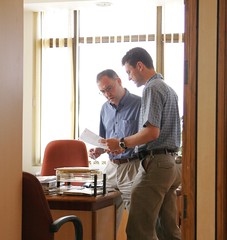 What should be the future agriculture and natural resource research agenda? That is the big question being asked in a series of electronic consultations being held in different regions of the world. The answer will determine the way that millions of dollars are spent in the coming years by the Consultative Group on International Agricultural Research (CGIAR). The regional e-consultations will feed into a Global Conference on Agricultural Research for Development (GCARD), to be held in Montpellier, France, in March 2010.
What should be the future agriculture and natural resource research agenda? That is the big question being asked in a series of electronic consultations being held in different regions of the world. The answer will determine the way that millions of dollars are spent in the coming years by the Consultative Group on International Agricultural Research (CGIAR). The regional e-consultations will feed into a Global Conference on Agricultural Research for Development (GCARD), to be held in Montpellier, France, in March 2010.